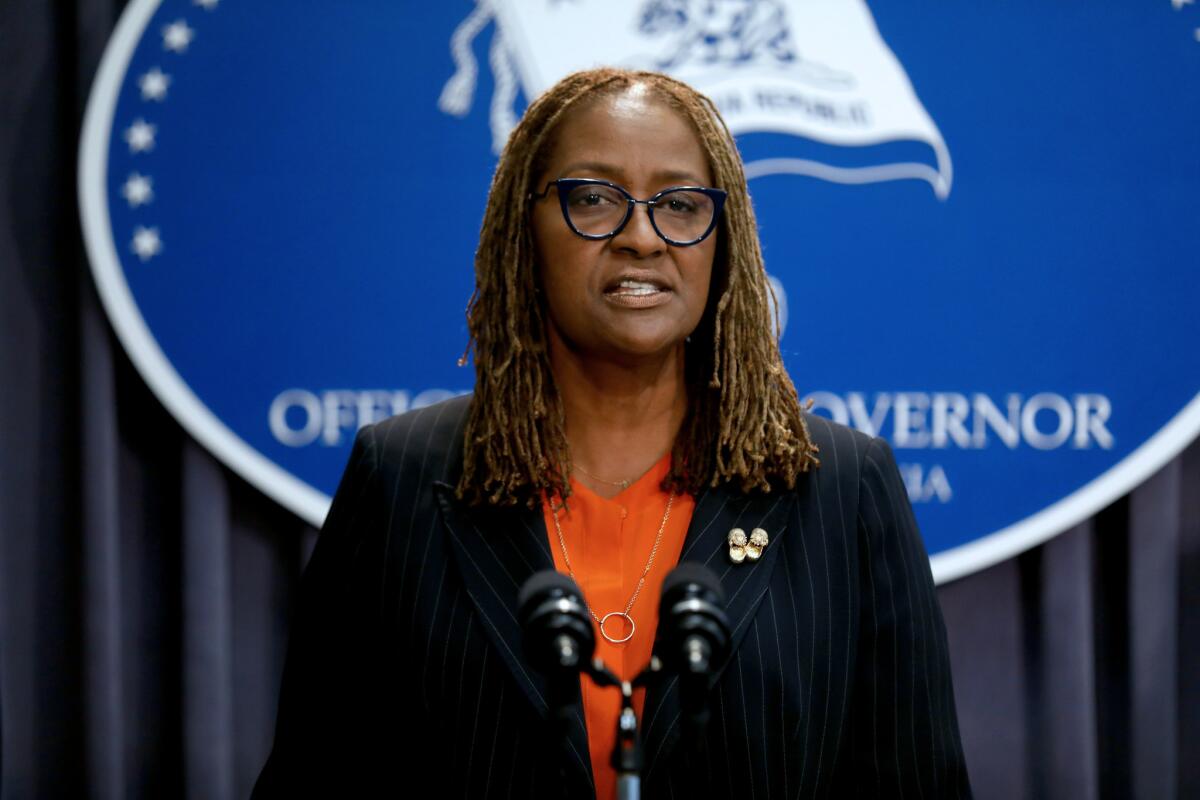Editorial: In Lacey and Mitchell, losses and gains for women in L.A. County

- Share via
As voters elected Holly Mitchell on Tuesday, paving the way for the first all-female Los Angeles County Board of Supervisors, they ousted Dist. Att. Jackie Lacey, the first and so far only woman elected countywide in the nation’s largest local jurisdiction, representing an astounding 10 million people.
The fact that there is nothing obviously inconsistent in those two historic moves serves in some manner to underscore the progress that women have made in elected office in L.A. and elsewhere, and the distance yet to be traveled. Fewer ceilings remain to be broken. But the number of women contending for public office is still disproportionately small.
In her concession speech Friday, Lacey noted that her mother had told her to remember that “no matter what happens, I made history.”
She did. For most of Los Angeles County’s 170-year existence, its voters elected men, and only men, to represent them. The supervisors, the sheriff, the district attorney, the assessor — all men. Gov. Jerry Brown appointed Yvonne Burke to fill a vacant Board of Supervisors seat in 1979, but voters replaced her the following year and the board was again all male (Burke was elected to a different board seat 12 years later). Gloria Molina was elected to the Board of Supervisors in 1991, but only after a judge threw out a prior election and ordered a new one because the all-male, all-white board had drawn district lines that unlawfully diluted Latino voting power. Burke’s and Molina’s ceiling-breaking were victories not only for women, but for people of color.
They were still the only women to have been elected to L.A. county office until 2012, the year Lacey launched her historic campaign for district attorney. It is noteworthy that she was not the only woman running, nor was she the only Black candidate. The diverse field was a result of societal and legal progress decades earlier that made college, law school and jobs at the District Attorney’s Office — and professional advancement — possible for more women and people of color.
That hardly diminishes the enormous achievement, or the additional burdens, expectations and criticisms, inherent in being the first. It is worth noting that Lacey’s reelection loss was due in part to vocal opposition from the Los Angeles chapter of Black Lives Matter and other groups led largely by Black women. They might have employed the same tactics to hound a white male district attorney who pursued the same policies as Lacey, but there are those in Lacey’s office who insist that the protesters’ rage was sharper and their tactics rougher precisely because she is Black and a woman.
By the time Molina was termed out on the Board of Supervisors, strong female candidates were ready to succeed her. Hilda Solis and Sheila Kuehl were elected in 2014. Janice Hahn and Kathryn Barger were elected two years later, making — for the first time — a majority female board of the nation’s most populous county, managing a budget in the tens of billions of dollars.
Has the gender shift made a difference? There were predictions of all sorts: The board would be more cooperative, because women don’t have the same competitive instincts as men, or the board would be more volatile, because women are so competitive with each other. Pick your sexist stereotype.
In fact the Board of Supervisors has been generally cooperative and productive, largely because members’ left-leaning politics align in a way that would be alien to the more politically divided boards of Molina’s era and the all-male boards before her. Even Barger, the board’s sole Republican, finds herself in policy agreement with her colleagues more often than not.
Meanwhile, the supervisors have hired women to be their chief executive officer, their county counsel, their health services director, and in fact leaders of about half of their departments. When she is sworn in next month, Mitchell will be joining a county government that enjoys a fairly healthy gender mix. Given the county’s track record, it’s hard to believe that it would have made such strides with male-majority boards.
Lacey will relinquish her office to George Gascón, but the ranks of female elected D.A.s in California will remain strong, with 26 of the state’s 58 top prosecutors being women.
At L.A. City Hall, down the street from the county Hall of Administration and Hall of Justice, the election of Nithya Raman will help tilt the City Council slightly back toward a modicum of equal representation. Currently, only two of the council’s 15 members are women.
When will we know that women have achieved equity in elected office? Maybe we won’t, because it will mean that electing a woman is so commonplace that it escapes notice, and candidates are seen merely as candidates. Mitchell’s election helps bring that day closer. As did Lacey’s.
More to Read
A cure for the common opinion
Get thought-provoking perspectives with our weekly newsletter.
You may occasionally receive promotional content from the Los Angeles Times.










